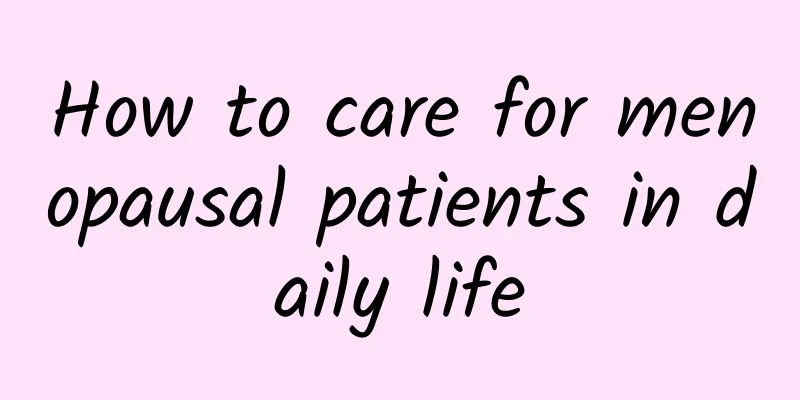Can irregular menstruation cause leg pain?

|
Speaking of irregular menstruation, I think it should be familiar to every woman, because women have menstruation since puberty, but due to not paying attention to maintenance in daily life, it is easy to have irregular menstruation. So what are the main symptoms after irregular menstruation occurs? Let me introduce the symptoms of irregular menstruation to you: 1. Early menstruation: Early menstruation means that the menstrual cycle is normal, but suddenly shortened, shorter than 21 days, and it occurs for more than 2 consecutive cycles, but the menstrual volume is normal. It belongs to ovulatory functional uterine bleeding with biphasic basal body temperature, short follicular phase, only 7-8 days, or luteal phase shorter than 10 days, or body temperature rise less than 0.5℃. 2. Delayed menstruation: Menstruation is usually regular, but delayed for more than 7 days, or even every 40 to 50 days, and occurs for more than two consecutive menstrual cycles, but the menstrual volume is normal. For those who ovulate, the basal body temperature is biphasic, but the follicular phase is long and the high temperature phase is low; for those who do not ovulate, the basal body temperature is monophasic. 3. Prolonged menstruation: The menstrual cycle is normal, the menstrual flow is normal, but the menstrual period is prolonged, the menstrual period exceeds 7 days, and even lasts for 2 weeks. Those with inflammation usually have lower abdominal pain, which is aggravated during menstruation. Usually, the amount of leucorrhea is heavy, yellow or yellow-white, thick, and has a smell. Those with incomplete corpus luteum atrophy also have heavy menstrual flow; those with prolonged endometrial repair still have a small amount of continuous vaginal bleeding after the normal menstrual period. 4. Irregular menstrual cycle: Menstruation is irregular, early or delayed, and the cycle is either shorter than 21 days or longer than 35 days. 5. Mid-menstrual bleeding: (also known as intermenstrual bleeding, ovulation bleeding) refers to bleeding that occurs between two regular menstrual cycles. It is caused by a temporary drop in estrogen levels, which causes the endometrium to lose hormonal support and leads to endometrial shedding. The above article is what I introduced to you today about the signs of irregular menstruation. Although you don’t need to worry too much about irregular menstruation, you still need to learn more about common sense, especially the symptoms of irregular menstruation. Knowing more about the symptoms and causes of irregular menstruation can help patients better understand and recognize them, make preparations, and win the best treatment opportunity before treatment. I hope my reply can help you. |
<<: How to regulate irregular menstruation and affect pregnancy
>>: Causes of dysmenorrhea in women due to adenomyosis
Recommend
Methods to improve pelvic fluid accumulation
Nowadays, gynecological diseases have become a ha...
Choose chicken breast and low-fat tenderloin slices for Mid-Autumn barbecue! Nutritionists teach you 3 tips for healthy eating so you don’t gain weight
The Mid-Autumn Festival is approaching, and barbe...
What are the causes of ectopic pregnancy?
What are the causes of ectopic pregnancy in women...
Treatment of cervical condyloma with Chinese and Western medicine
In daily life, cervical warts are a common sexual...
What are subserosal uterine fibroids? What are the symptoms of subserosal uterine fibroids?
Subserosal uterine fibroids are a common type of ...
Treatment of uterine fibroids Is the high-risk group for uterine fibroids around 50 years old?
Uterine fibroids should be discovered in time, ot...
There are two main types of dysmenorrhea
Dysmenorrhea is something that female friends oft...
What is the reason for normal menstruation without ovulation?
Normal menstruation without ovulation may be caus...
I have gout and can’t eat beans? Control uric acid first, no need to worry about imperial disease
If you have gout, you can’t eat beans? Doctors po...
Women can judge pelvic peritonitis by leucorrhea
Pelvic peritonitis is very common for many women....
What medicine is good for vulvar itching
It is necessary to master the methods of traditio...
People should always pay attention to the care methods of uterine fibroids
Uterine fibroids are a common disease among women...
The main symptoms of tumorous ovarian cysts
Tumorous ovarian cysts are one of the more common...
What is the cause of moderate chronic cervical erosion? Uncover the cause of moderate chronic cervical erosion
Usually, many reasons may cause women to develop ...
Does female cervical erosion have symptoms of increased leucorrhea?
What are the symptoms of female cervical erosion?...









